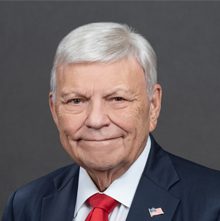Government’s Vaccine Mandate and Logistics Workers
Trucking groups filed a lawsuit Nov. 9 against the Biden administration over its vaccine mandate for large employers.

The end of the calendar year 2021 will be upon us by the time The Wholesaler magazine is published and distributed, ending a year in which the PVF industry has dealt with many uncertainties affecting supply and demand. These problems will persist well into 2022 and possibly beyond.
As of this writing, President Biden’s reconciliation bill is still in limbo, exacerbating the ability of executive decision-making regarding final investment decisions on energy projects. In addition, the Biden administration’s approach to additional taxation on the energy sector along with increased and unnecessary regulation on energy production and transportation to market will cloud the decision-making process.
America’s supply chain crises may soon become far worse. A number of trucking groups led by the American Trucking Associations filed a lawsuit Nov. 9 against the Biden administration over its vaccine mandate for large employers. The administration’s vaccine mandate affects companies with more than 100 employees; however, small truck companies do not have the resources to absorb additional drivers who quit larger firms over the mandate.
Logistics workers are already wrestling with the worst supply-chain issues ever seen, per Lisa Anderson, president of the logistics group LMA Consulting. “It’s unprecedented. It’s never happened before,” she noted.
Right now, logistics issues have made it difficult to find replacement parts for trucks. Businesses find themselves in a Catch-22; they fix their trucks, but trucks are needed to transport the repair parts.
Cathy Robertson, president of Logistics Trends and Insights, stated it’s that it’s unclear right now what the long-term impact of the vaccine mandate will be. If truckers quit, the mandate could damage America’s logistics system. “It really hurts larger trucking companies more than anything else,” she added. Whatever the case, the mandate will exacerbate current supply chain issues.
Higher Energy Prices this Winter
“Oil continued its rally of almost 30 percent as COVID-19 peaked and the United States opened up travel to vaccinated travelers,” per Jay Hatfield, chief executive officer at Infrastructure Capital Advisors. “We expect oil to continue its rally as we head into November and December; colder weather triggers more demand for heating oil and the holidays drive incremental gasoline demand.”
Infrastructure Capital Advisors expects oil to trade in the $80 to $100 range for the remainder of the year and 2022, citing “incremental demand related to international travel and fuel switching as global natural gas prices trade at the energy equivalent rate of $180 barrel.”
As of this writing, WTI I is trading at $82.90, Brent at $84.60 and natural gas at $5.893.
“Global oil inventories remain tight as demand growth remained firm, but production growth lags,” noted Marshall Steeve, an energy markets analyst at IHS Markit. The OPEC countries and their allies are sticking with planned monthly increases of 400,000 Bpd, while U.S. production is actually in decline.
The Energy Information Administration forecasts the U.S. inventory draws of natural gas will be above the five-year average this winter. That factor, along with rising U.S. natural gas exports and relatively flat production through January, will keep U.S. natural gas prices near recent levels before downward pressure emerges.
Energy commodities “can’t go up every day; we can expect this sector to remain volatile,” said analysts at Sevens Report Research. “However, if supply remains limited and demand is robust, and if we get an early and cold start to winter, we should be prepared for much higher energy commodity prices.”
The decline in crude oil inventories also supports drilling activity growth in 2022. Crude oil inventories have gradually declined over the past 12 months. Cushing, Okla., inventories have declined 42 percent this year, currently 26 percent below the historical five-year average.
OPEC producers have done well to hold agreed-upon production limits for the past two years; this will likely continue as most OPEC members are enjoying the price stability. Oil price stability offers operators the ability to plan and budget with additional confidence.
Most onshore producers have spent the past couple of years consolidating spending and conserving capital, learning to operate with considerably higher fiscal and operational discipline, which bodes well for the upcoming growth cycle.
Energy Investments
Cumulative investment requirements in the oil sector will amount to $11.8 trillion from 2021 to 2045. Of this, 80 percent, or $9.2 trillion, is directed toward the upstream, the bulk of which is in North America, as U.S. tight oil drives medium-term non-OPEC supply growth. Downstream and midstream investment necessitates another $1.5 trillion and $1.1 trillion, respectively, to expand and maintain the associated refinery, storage and pipeline systems required to bring oil to market.
An enhanced oil recovery (EOR) technique involves the injection of CO2 gas into the well to bring the oil to the surface. Per the U.S. Department of Energy, more than 60 percent of the EOR in the United States is completed in this manner. Denbury Inc. (Plano, Texas) is one of the leaders in this field. Denbury is extending a 20-inch-diameter CO2 pipeline in southeastern Montana by 105 miles to transport 75 million cubic feet per day along existing rights-of-way.
The U.S. ethanol sector has recently seen production hit its highest level since the pandemic-driven lockdowns, while spot prices have approached a seven-year high alongside surging oil prices. Strong corn harvests provide plenty of cost-effective feedstock.
Ethanol producers are focusing on keeping their facilities in ship-shape condition as they contemplate expansions. Industrial Info Research is tracking 160 active maintenance projects in the United States that are slated for startup by the end of the second quarter of 2022, the bulk of which are in the Midwest region.
Ford Motor Co. and South Korean battery maker SK Innovation are planning to spend $11.4 billion on new manufacturing plants in Tennessee and Kentucky.
The first project will be a $5.6 billion “mega campus” named Blue Oval City in Stanton, Tenn. The second project, named BlueOvalSK, is the $5.8 billion construction of two battery plants in Glendale, Ky.
With supply-chain constraints, port-of-entry constraints, escalating energy costs, trucker and skilled worker shortages, close contact with your manufacturer/supplier must be maintained to avoid stock outages, unexpected delays in shipping as well as anticipated price increases as we move into 2022.
PVF Roundtable News
The 2021 Christmas party “Fill the Pantry” was held Dec. 7 at The Bell Tower on 34th in Houston. This was the final networking meeting of 2021, and we anticipated a hardy turnout and healthy support for the PVF Roundtable’s charitable initiative.
The golf tournament and the Trout Blast are the two major fundraising events held by the PVF Roundtable Charitable Foundation. These funds are dedicated to the PVF Roundtable Scholarship Programs.
The 2021 PVF Trout Blast was held in Matagorda, Texas, Oct. 7-8. This year’s event was a record-breaker, thanks to all the volunteers and committee member efforts.
As a member of the board of directors, and I speak for all members, we thank you for your participation in these events.
The networking meetings are a unique venue for you, and your associates, to network with your peers in the PVF industry. These events provide the platform to share information, discuss pertinent issues, meet new contacts, develop new and long-lasting friendships and pursue new opportunities in the industry.





